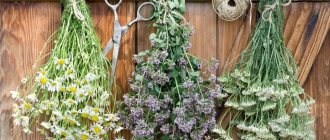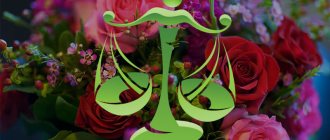There is always a reason to give flowers. Holiday, birthday, wedding, family celebration - no matter how luxurious a gift is given for these events, it will be incomplete without “floral accompaniment”. Even a modest bouquet of fresh flowers with your own hands evokes the most incredible emotions, especially if it can speak in a special “secret” language.
Symbolism of flower arrangements
Not only does each plant individually mean certain feelings, but also the combination of several species with each other. For example, a single scarlet rose expresses passion, but next to white and pink buds, it can be interpreted as suggesting a serious relationship based on love and trust. It is interesting that it is generally not recommended for established, fairly old people to give the “queen of gardens”, either in a single copy or in mono-bouquets. This is considered overly playful.
Only in early youth is it appropriate to give spring lilac compositions. Her lush brushes indicate the birth of first love. More mature and less ephemeral feelings are expressed with a bouquet of tulips, irises and chrysanthemums.
The combination of lilies and eustoma can be perceived as a hidden compliment to girlish beauty. Camellias, peony roses or gardenias also speak of the admirer's admiration. But if the bouquet arrangement consists mainly of exotic flowers, then the girl to whom it is addressed is considered unusual and stands out from the crowd.
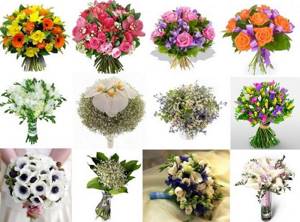
You should be careful when giving daffodils, yellow carnations, and petunia to your loved ones and loved ones - these plants symbolize negative feelings.
Bouquets of fresh flowers
Bouquet for the bride of roses. This flower is the most popular among lovers. Tender and soft, with a light pleasant aroma, they have always been a symbol of love and devotion. You can choose any colors: beige, peach, tea, classic white and decorate with beads, ribbons, transparent fabric, and greenery. Gypsophila branches look great or combine several shades of roses. Contrasting colors can be laid out in a circle using a bouquet maker to create a neat ball.
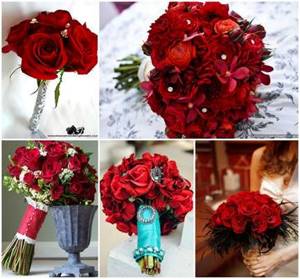
Flowers of the first freshness
The beauty of living plants is fully revealed only if they are perfectly fresh. Buds losing their elasticity, drooping, matte leaves, and other signs of wilting immediately destroy the favorable impression. To prevent this from happening, the plants need to be properly prepared.
Cutting and “drinking regime”
If the components for the arrangement are collected in your own garden, it is advisable to choose a clear, dry day and start cutting in the early morning or evening, after the sun has set. You can store the “harvest” in a cool room or on a refrigerator shelf at a temperature of +5ºС. Before you start assembling the bouquet, the plants are well saturated with water, especially when you plan to make the composition on their own stems.
To prevent rapid fading you need to:
- Remove the lower leaves, and the roses also have thorns, otherwise they will rot in the water.
- Make an oblique cut on the stems, holding them under water (this way no air will get inside). Use only a stationery knife, and not scissors, which crush the capillary mesh.
- The dense stems of roses and other shrub plants require additional notching to effectively absorb water.
- Hydrangea can be “invigorated” with boiling water. The stem is immersed in it for 15 - 20 minutes. Then the part standing in the boiling water is removed, and the inflorescences, thanks to the procedure, “live” much longer.
- The cut on the stems of dahlias and peonies is burned on fire, otherwise they will release toxins.
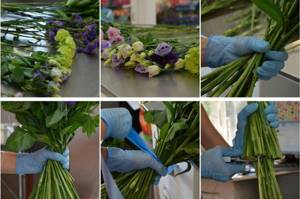
The water in which the flowers stand must at least be filtered. It’s better to use a well or rainwater.
Neighborhood
There are plants that literally destroy their “companions” in a bouquet arrangement and, conversely, are some kind of resuscitators. The former include daffodils, hyacinths, lilies of the valley and sweet peas. The second ones include geranium, juniper, cypress and thuja.
It is highly undesirable to combine bulbous and woody plants. The exception is roses and lilies, they do not affect each other in any way and look very harmonious when paired. In general, the “queen of gardens” can hardly stand the proximity of not only other flowers, but also their “relatives”, which differ in variety or color. Roses of different shades are kept in separate containers and added to the arrangement immediately before the special event.
Food floristry also requires some caution. Ripe fruits: apples, pears, figs, often used in flower arrangements, emit ethylene, a gas that accelerates the ripening process. Roses, delphinium, tulips and carnations, being next to them, quickly fade and crumble.
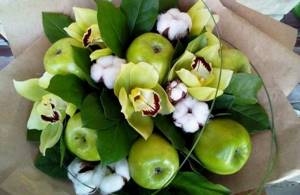
Rules for composing successful bouquet arrangements
Even so-called free arrangements that do not have strict geometry are built according to certain laws. Otherwise, it is no longer creativity, but chaos. When making bouquets of fresh flowers with your own hands, you should consider that:
- The largest and brightest buds are located in the center, and the light ones are closer to the edges. This makes the bouquet arrangement seem more voluminous.
- There should not be a lot of decorative greenery; attention is drawn primarily to the flower buds.
- It is advisable that the inflorescences are not located close to each other, otherwise they will be difficult to see.
- Plants should be given a natural position, without trying to bend or twist them forcibly. It is also recommended to vary the height of the arrangement components.
- It is important to use flowers at different stages of ripening: from tightly closed buds to almost fully opened specimens.
The listed rules are allowed to be violated if the result is harmonious and effective.
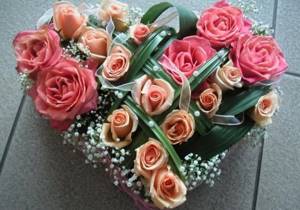
Basic rules for creating a bouquet using fresh flowers
If a girl is a supporter of the traditional style and prefers a natural composition, you need to adhere to certain rules for creating a bouquet.
- The more magnificent the bride’s outfit, the more modest the bouquet, and, of course, vice versa.
- You need to choose flowers with not fully opened buds, strong petals, and safe for the young. The prickly thorns of roses can not only ruin the bride’s outfit, but also scratch her hands, and the long stamens of lilies can stain her dress and suit.
- It is worth choosing seasonally blooming flowers that correspond to the time of year, because imported exotic flowers are unlikely to remain fresh for long.
Editor's choice: Applications for organizing a wedding - the most convenient developments
- If you have never made a bouquet, try creating a composition in beige colors, and only then get to work.
- It wouldn’t hurt to consult a florist or look for ideas on the Internet or flower shops.
- The bouquet should look harmonious and match the colors of the bride's outfit. Since the newlywed traditionally tries to wear a light dress, the flowers are selected from the same palette of shades. A bright bouquet can be created only if the image is complemented with the same accessories.
- You can make a composition from exotic flowers only if you are sure that they do not cause you allergies.
- Be careful when choosing colors. Even if you choose buds, they should be dense, the petals should be free of spots and fading leaves.
- Try not to make the created masterpiece heavy. You will need to walk around with it all day and throw it to the bridesmaids.
Bouquets for all occasions
Living plants are good everywhere and always. Unlike analogues made from fabric or polymer clay, their perfect beauty is created by nature itself. All that remains is to make a little effort and skillfully emphasize it. The most convenient way is to create a bouquet of fresh flowers with your own hands step by step, following photo or video instructions.
Country basket "For Teacher's Day"
Any owner of a summer cottage can afford such a touching and charming “congratulation” to a beloved mentor. In a basket, and also on a floristic base, autumn perennials will feel comfortable and will last for at least 2 weeks. And during a lesson, the teacher will accidentally look at this beauty and smile.
You will need:
- any autumn perennials, in this case zinnias, asters and bush chrysanthemums, viburnum berries;
- wicker basket with a high handle;
- floristic “oasis”;
- auxiliary tools: stationery knife, scissors.
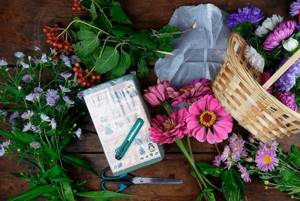
Line the bottom of the basket with polyethylene. You can take a regular bag, as in this case, or a special “mica” floral film. We cut out the “oasis”, adjusting it to the shape of the basket, moisten it and additionally wrap it in cling film. We leave the upper part where the plants will be attached open. We begin to assemble a bouquet arrangement, following the rule - from the largest buds to the smallest.
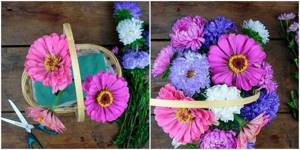
We use small chrysanthemums as a filler for the arrangement. At the very end we add branches of ripe viburnum; they will add variety to this “autumn symphony”.
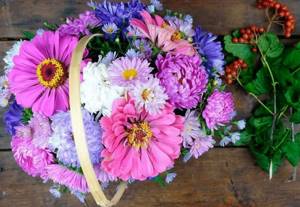
A very delicate and full of warmth composition is ready. Its compact size and light weight make it possible to give it as a gift on September 1, although florists for the main school holiday recommend options without baskets - they are hard to see in photographs.
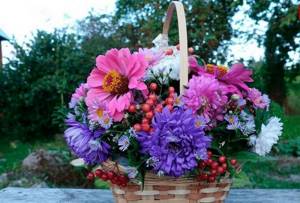
Balloon bouquet for a wedding in a classic style
The exquisite arrangement called “pomander” is attractive due to its convenient design and extravagant appearance. Another plus is its ease of execution, although at first glance it seems that only a professional florist can cope with such a task.
For an original wedding bouquet of fresh flowers you will need very little:
- any plants in delicate pastel colors (ranunculus, muscari, mint, asparagus and rosemary are used in the example);
- satin ribbons and lace for decoration;
- piaflor (“oasis”);
- floral wire and scissors.
We lay a satin ribbon on the wire, and place lace on top of it. Twist the loop.
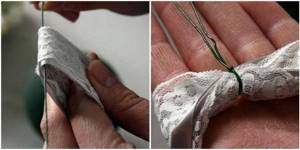
Then we insert the wire bracket deeply into the ball so that both ends go right through and “look out” on the other side. We spread them in different directions and pierce the ball again to fix it.
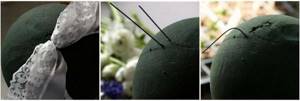
From the braid we make a lush bow with a loop holder. Cover the textile element with film and immerse the piaflor in settled water at room temperature. When the “oasis” is sufficiently saturated, we begin to decorate it. First we distribute the ranunculus, then the spicy herbs. And we use purple muscari as bright accents. When the ball is completely ready, the film from the bow needs to be removed.
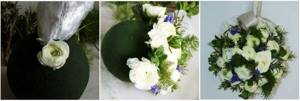
Bride's bracelet made of field herbs
An unusual “green” decoration is suitable not only for the newlywed, but also for her girlfriends. Stylish, unusual and comfortable - your hands remain free during the celebration, and the bouquet (aka bracelet) is nearby at all times.
You will need:
- field or garden plants;
- floral glue, sponge and wire;
- lid from an ice cream or mayonnaise bucket;
- anchor tape - similar to tape, but waterproof;
- tapes – nylon and fabric.
- Let's make the base for the bouquet. From the plastic cover we cut out a plate with two side “ears”. A ribbon will be threaded through them to hold the bouquet on the forearm. The size of the part is about 5 cm. You can see how it should look in the photo.
- We form a hemisphere from a floral sponge, D 4.5 cm. We glue both elements with waterproof glue and additionally fix them with anchor tape. After this, we place the structure in a container with water so that the sponge is saturated.
- Let's prepare the flowers. Since the chosen field plants are very delicate and unstable, they need to be processed using special technology. The main task: to saturate the herbs with water as much as possible so that they do not wither before the end of the wedding celebrations. To do this, we strip the stems of the lower leaves and immerse the tips - up to 3 cm, no more - in boiling water for a few seconds. Then we cut off the burned areas, put the herbs in plain water and place them in the refrigerator for 2 hours. This shock therapy helps open the thin capillaries and they absorb much more water than they could.
- After all the preparations are made, we begin assembling the “live” bracelet. First, using sprigs of greenery, we set the teardrop shape of the composition. We add small inflorescences that support its asymmetrical character. We mark the center with the largest bud, in this case a chamomile. And then we distribute the remaining components.
- We thread the ribbon holder parts into the ears to tie them around the arm.
- The final stage is watering. While attaching the flowers to the floral base, some of the water was squeezed out of it. Now you need to compensate for the lost liquid by carefully adding it drop by drop to the arrangement.
- When the flower petals are dry after the shower, decorate them with ladybird decorations placed on floral glue. You can make this charming bridal bouquet from fresh flowers with your own hands, with a little patience and imagination (see photo):
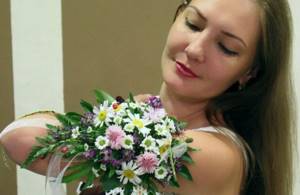
Mini bouquet for the first date
Young people will have to think a lot to come to a meeting with the girl they like, with or without flowers, according to the new fashionable etiquette. Bringing “a million scarlet roses” means showing yourself to be a spendthrift who wants to show off and oblige his counterpart with excessive generosity. It’s even worse to show up empty-handed, admitting your own pettiness and greed.
The best option in this situation is mini-bouquets, the so-called “compliments”, consisting of a minimum number of flowers. This is an unobtrusive sign of attention, which, moreover, will not tear off the girl’s hands if the couple decides to take a short walk together.
For a mini bouquet of fresh flowers you will need only 3 components:
- sprigs of Spanish gorse;
- eustoma;
- sheet of kraft paper.
We put together a small arrangement of plants. We spread the paper and lay our mini-bouquet diagonally. First, fold the left corner of the package, then pick up the bottom, folding it into an envelope. We wrap the right part, which is much longer, around the entire composition and lay it beautifully in front. We tie it with a contrasting burlap bow.


